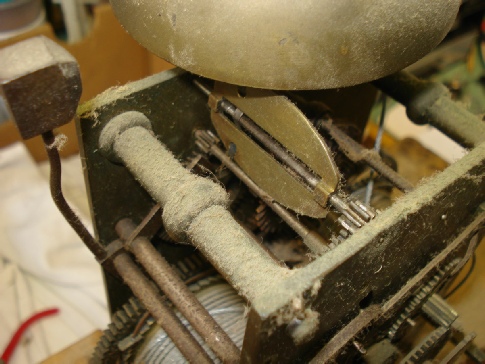
© Mathew Porton FBHI 2023. Tempus Fugit Velut Umbra Barnt Green, Worcestershire, West Midlands
Further Examples of Work on Clocks
Although clocks can suffer wear and tear or damage to any part there are many common areas where work is needed after running for several years:-
In many cases clocks require a good clean, lubrication with fresh oil and some minor correction of wear. The clock shown left had been stored for some time without being run. It had a great deal of dirt all through the movement and the oil had dried up into sticky or solid deposits. Running a clock in that condition (if it would run at all) would quickly cause parts to wear and it would then need additional remedial work.
The part shown to the left is a strike lever from a modern longcase movement. The lever is operated by a star wheel turning and pushing down one side of the lever. The hardened steel wheel has worn a groove in the lever over the years. At a previous service the repairer has adjusted the wheel to operate on a different part of the lever so there were now two grooves. When I serviced the clock it was not possible to adjust further without risk of the wheel falling back into one of the grooves already cut causing further wear or causing problems with the running of the striking mechanism. To solve the problem I laser welded steel onto the lever to fill the grooves back in with hardened steel and then re-polished back to its original form. This now allows the strike to operate safely and consistently.



The picture to the right shows the same clock movement after servicing. The movement has been thoroughly cleaned and degreased. Serviced, reassembled and lubricated.


The movement to the right is from an 8-day longcase which originally had operated a moon phase dial and also a centre date hand. At some stage in the life of the clock both of these had been disconnected. The hand and the wheel to drive both functions had been discarded or lost.
The clock was serviced and a new wheel with flags to drive the moon and date functions was designed and made. This can be easily seen as the shiny toothed wheel on the right of the picture. A new post to mount the wheel and a date hand were also made. These were made to a conjectured design which was functional and also appropriate for the age of the clock.
With conservation in mind these parts were clearly identifiable as new, no changes at all were made to the clock itself, only the original hole for the post mounting was re-used without alteration. All of the new parts can be easily removed making the restoration work completely reversible in accordance with good conservation practice.
The inset moon phase dial can be seen below along with the replacement date hand.

At a much smaller scale the component in the process of being made to the right is a new balance staff for a small ships style clock. The movement is similar to a large mechanical watch. The original balance staff had broken at the pivot due to a hard knock to the clock. The pivot is 0.09mm diameter and so is very fragile.
The smaller picture shows the finished staff with the balance riveted on.
